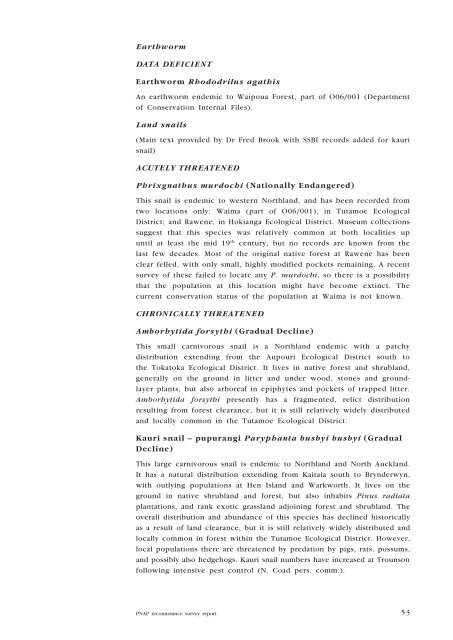Natural areas of Tutamoe Ecological District (3. Ecological character)
Natural areas of Tutamoe Ecological District (3. Ecological character)
Natural areas of Tutamoe Ecological District (3. Ecological character)
You also want an ePaper? Increase the reach of your titles
YUMPU automatically turns print PDFs into web optimized ePapers that Google loves.
earthworm<br />
dAtA deFIcIent<br />
Earthworm rhododrilus agathis<br />
An earthworm endemic to Waipoua Forest, part <strong>of</strong> O06/001 (Department<br />
<strong>of</strong> Conservation Internal Files).<br />
land snails<br />
(Main text provided by Dr Fred Brook with SSBI records added for kauri<br />
snail)<br />
Acutely threAtened<br />
Phrixgnathus murdochi (Nationally Endangered)<br />
This snail is endemic to western Northland, and has been recorded from<br />
two locations only: Waima (part <strong>of</strong> O06/001), in <strong>Tutamoe</strong> <strong>Ecological</strong><br />
<strong>District</strong>; and Rawene, in Hokianga <strong>Ecological</strong> <strong>District</strong>. Museum collections<br />
suggest that this species was relatively common at both localities up<br />
until at least the mid 19 th century, but no records are known from the<br />
last few decades. Most <strong>of</strong> the original native forest at Rawene has been<br />
clear felled, with only small, highly modified pockets remaining. A recent<br />
survey <strong>of</strong> these failed to locate any P. murdochi, so there is a possibility<br />
that the population at this location might have become extinct. The<br />
current conservation status <strong>of</strong> the population at Waima is not known.<br />
chrOnIcAlly threAtened<br />
Amborhytida forsythi (Gradual Decline)<br />
This small carnivorous snail is a Northland endemic with a patchy<br />
distribution extending from the Aupouri <strong>Ecological</strong> <strong>District</strong> south to<br />
the Tokatoka <strong>Ecological</strong> <strong>District</strong>. It lives in native forest and shrubland,<br />
generally on the ground in litter and under wood, stones and groundlayer<br />
plants, but also arboreal in epiphytes and pockets <strong>of</strong> trapped litter.<br />
Amborhytida forsythi presently has a fragmented, relict distribution<br />
resulting from forest clearance, but it is still relatively widely distributed<br />
and locally common in the <strong>Tutamoe</strong> <strong>Ecological</strong> <strong>District</strong>.<br />
Kauri snail – pupurangi Paryphanta busbyi busbyi (Gradual<br />
Decline)<br />
This large carnivorous snail is endemic to Northland and North Auckland.<br />
It has a natural distribution extending from Kaitaia south to Brynderwyn,<br />
with outlying populations at Hen Island and Warkworth. It lives on the<br />
ground in native shrubland and forest, but also inhabits Pinus radiata<br />
plantations, and rank exotic grassland adjoining forest and shrubland. The<br />
overall distribution and abundance <strong>of</strong> this species has declined historically<br />
as a result <strong>of</strong> land clearance, but it is still relatively widely distributed and<br />
locally common in forest within the <strong>Tutamoe</strong> <strong>Ecological</strong> <strong>District</strong>. However,<br />
local populations there are threatened by predation by pigs, rats, possums,<br />
and possibly also hedgehogs. Kauri snail numbers have increased at Trounson<br />
following intensive pest control (N. Coad pers. comm.).<br />
PNAP reconnasance survey report<br />
53

















